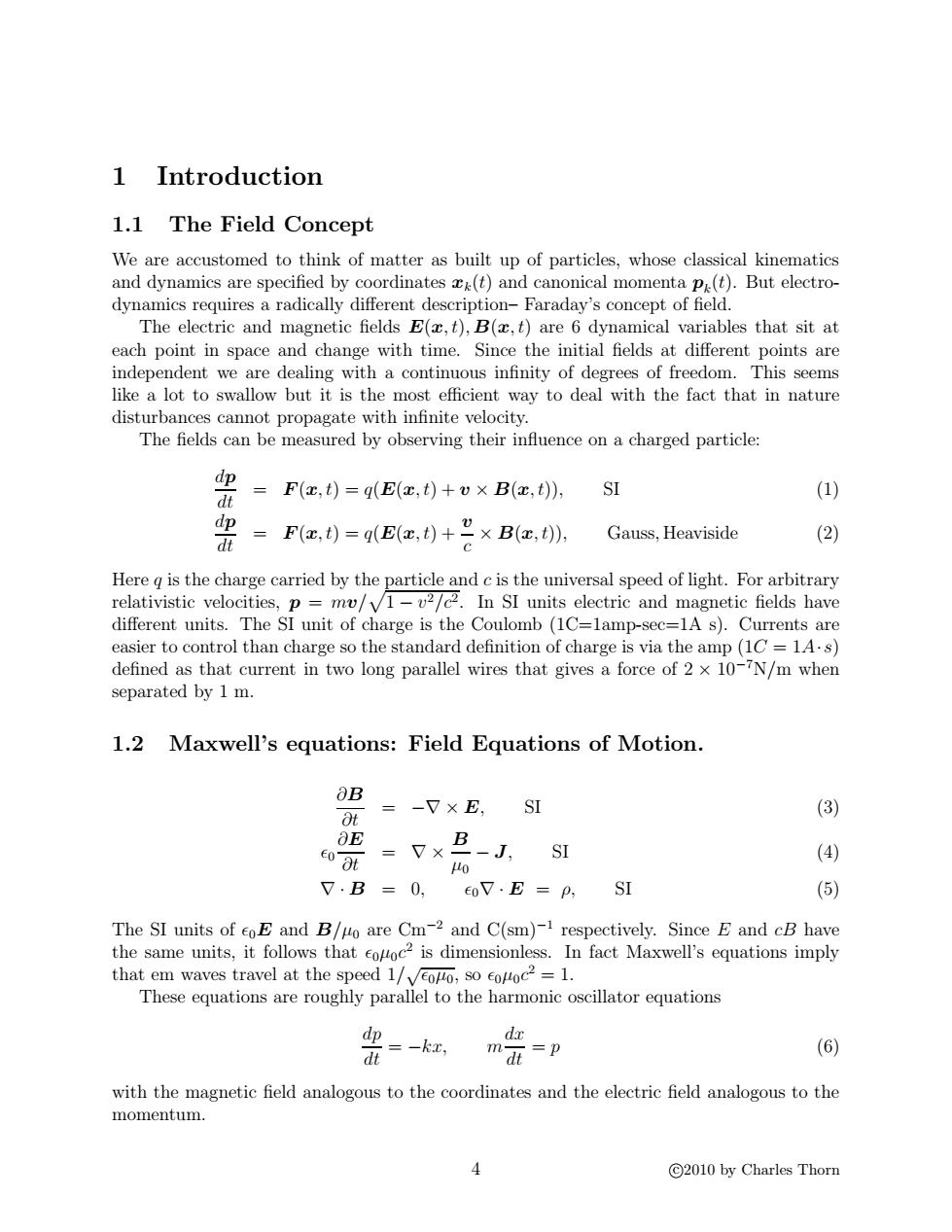正在加载图片...

1 Introduction 1.1 The Field Concept We are accustomed to think of matter as built up of particles,whose classical kinematics and dynamics are specified by coordinates (t)and canonical momenta p(t).But electro- dynamics requires a radically different description-Faraday's concept of field. The electric and magnetic fields E(x,t),B(x,t)are 6 dynamical variables that sit at each point in space and change with time.Since the initial fields at different points are independent we are dealing with a continuous infinity of degrees of freedom.This seems like a lot to swallow but it is the most efficient way to deal with the fact that in nature disturbances cannot propagate with infinite velocity. The fields can be measured by observing their influence on a charged particle: dp dt F(x,t)q(E(x,t)+vx B(x,t)), SI (1) dt =Pz,)=gEz,)+是×B(e,。 dp Gauss,Heaviside (2) Here g is the charge carried by the particle and c is the universal speed of light.For arbitrary relativistic velocities,p=mv/v1-v2/c2.In SI units electric and magnetic fields have different units.The SI unit of charge is the Coulomb (1C-lamp-sec=1A s).Currents are easier to control than charge so the standard definition of charge is via the amp (1C =1A.s) defined as that current in two long parallel wires that gives a force of 2 x 10-7N/m when separated by 1 m. 1.2 Maxwell's equations:Field Equations of Motion. ∂B =-V×E,SI (3) Ot E 0Vx B J.SI (4) 0 7.B=0,o7·E=p, SI (5) The SI units of coE and B/uo are Cm-2 and C(sm)-1 respectively.Since E and cB have the same units,it follows that eoloc2 is dimensionless.In fact Maxwell's equations imply that em waves travel at the speed 1/veouo,so couoc2 =1. These equations are roughly parallel to the harmonic oscillator equations d迎-k, dx (6) dt =p with the magnetic field analogous to the coordinates and the electric field analogous to the momentum. ©2010 by Charles Thorn1 Introduction 1.1 The Field Concept We are accustomed to think of matter as built up of particles, whose classical kinematics and dynamics are specified by coordinates xk(t) and canonical momenta pk (t). But electrodynamics requires a radically different description– Faraday’s concept of field. The electric and magnetic fields E(x,t), B(x,t) are 6 dynamical variables that sit at each point in space and change with time. Since the initial fields at different points are independent we are dealing with a continuous infinity of degrees of freedom. This seems like a lot to swallow but it is the most efficient way to deal with the fact that in nature disturbances cannot propagate with infinite velocity. The fields can be measured by observing their influence on a charged particle: dp dt = F(x,t) = q(E(x,t) + v × B(x,t)), SI (1) dp dt = F(x,t) = q(E(x,t) + v c × B(x,t)), Gauss, Heaviside (2) Here q is the charge carried by the particle and c is the universal speed of light. For arbitrary relativistic velocities, p = mv/ p 1 − v 2/c2 . In SI units electric and magnetic fields have different units. The SI unit of charge is the Coulomb (1C=1amp-sec=1A s). Currents are easier to control than charge so the standard definition of charge is via the amp (1C = 1A·s) defined as that current in two long parallel wires that gives a force of 2 × 10−7N/m when separated by 1 m. 1.2 Maxwell’s equations: Field Equations of Motion. ∂B ∂t = −∇ × E, SI (3) 0 ∂E ∂t = ∇ × B µ0 − J, SI (4) ∇ · B = 0, 0∇ · E = ρ, SI (5) The SI units of 0E and B/µ0 are Cm−2 and C(sm)−1 respectively. Since E and cB have the same units, it follows that 0µ0c 2 is dimensionless. In fact Maxwell’s equations imply that em waves travel at the speed 1/ √0µ0, so 0µ0c 2 = 1. These equations are roughly parallel to the harmonic oscillator equations dp dt = −kx, m dx dt = p (6) with the magnetic field analogous to the coordinates and the electric field analogous to the momentum. 4 c 2010 by Charles Thorn